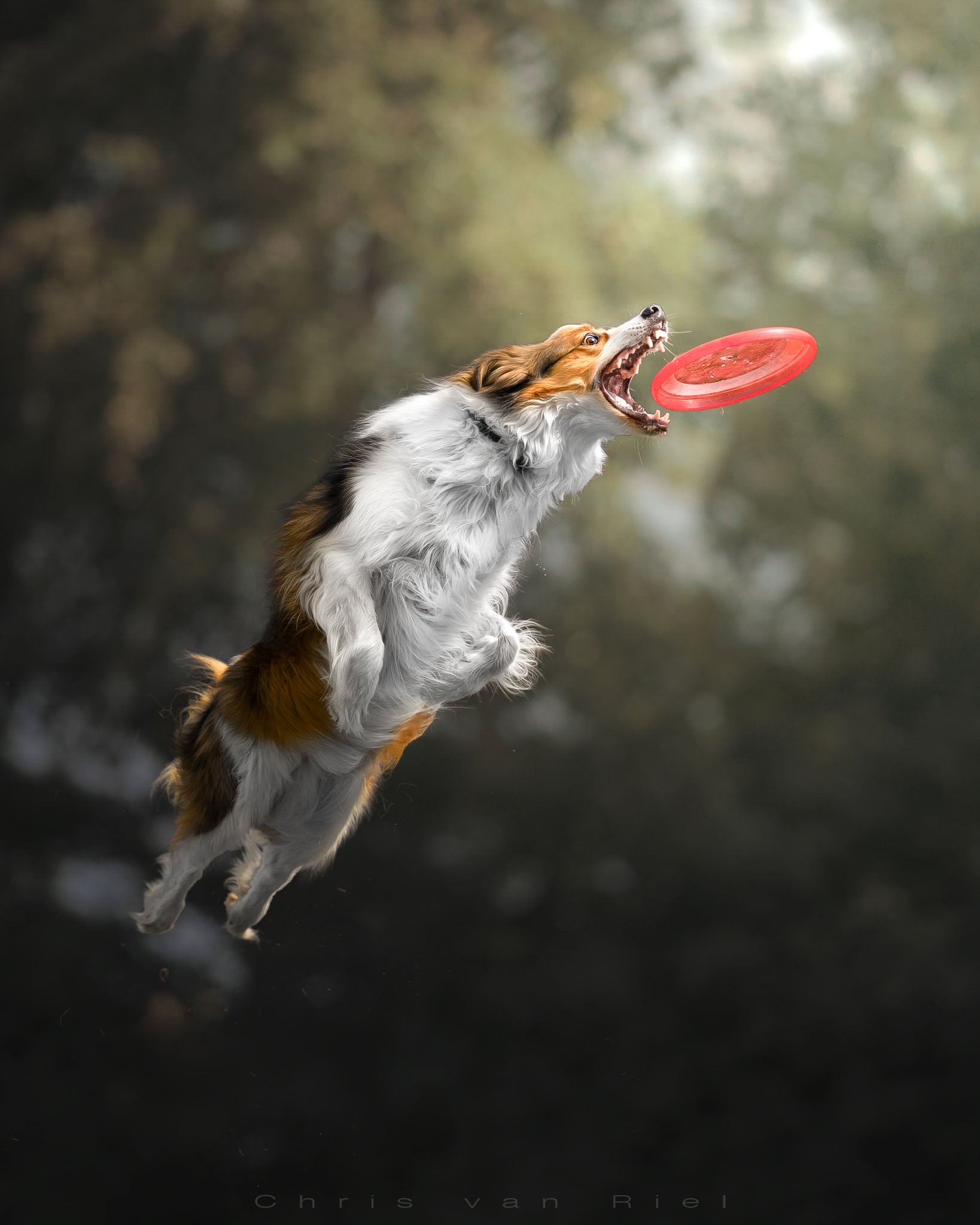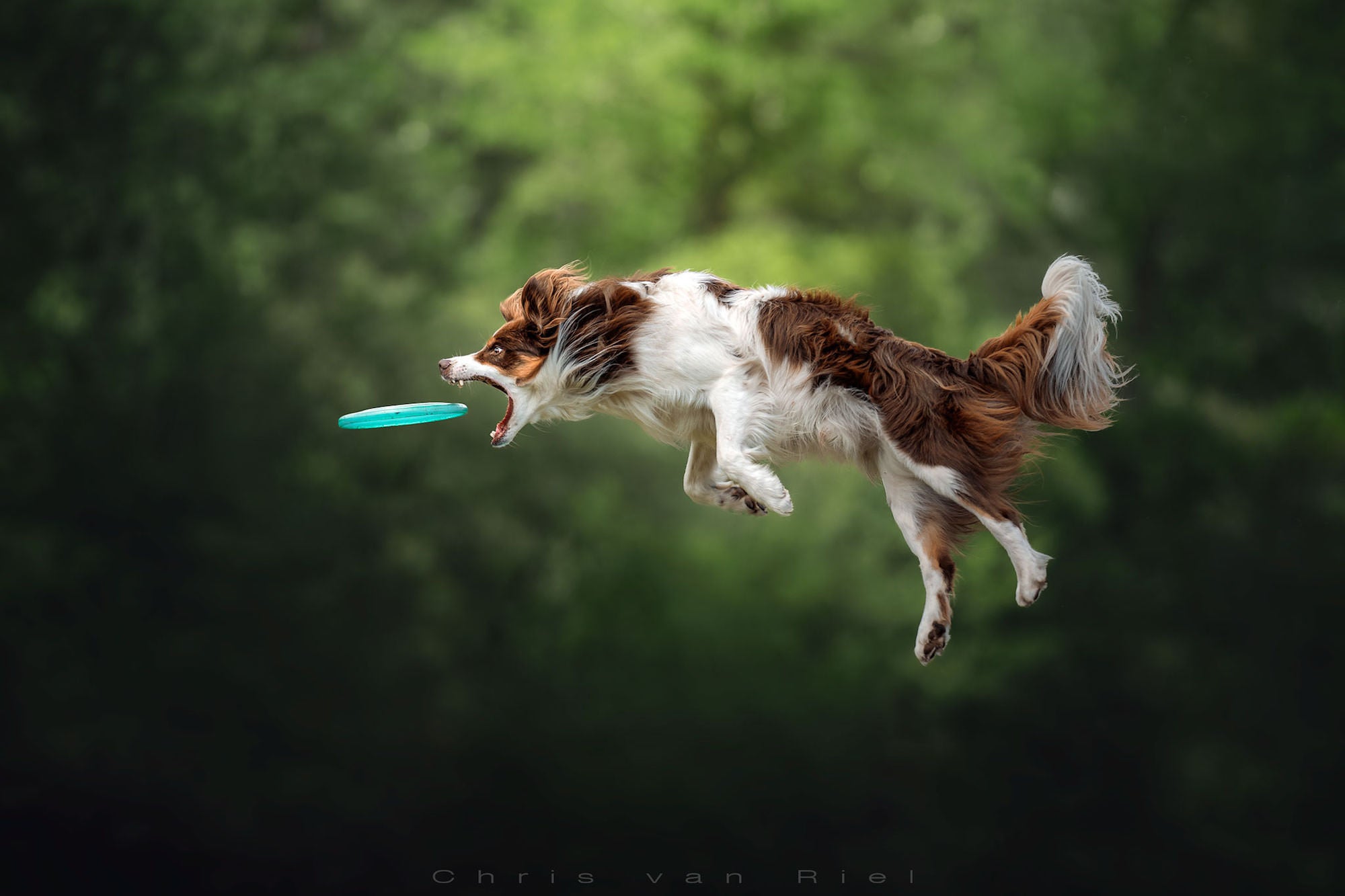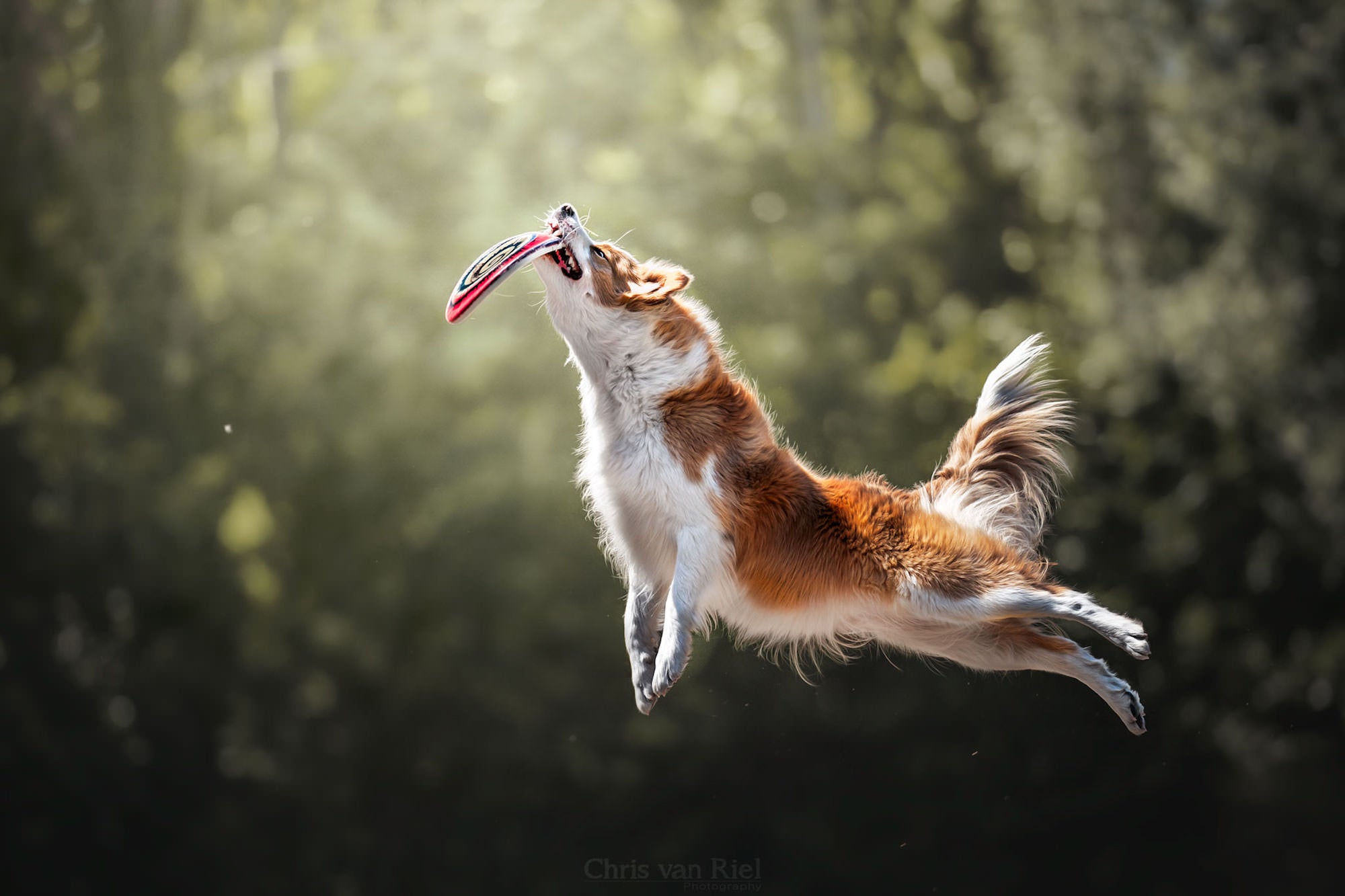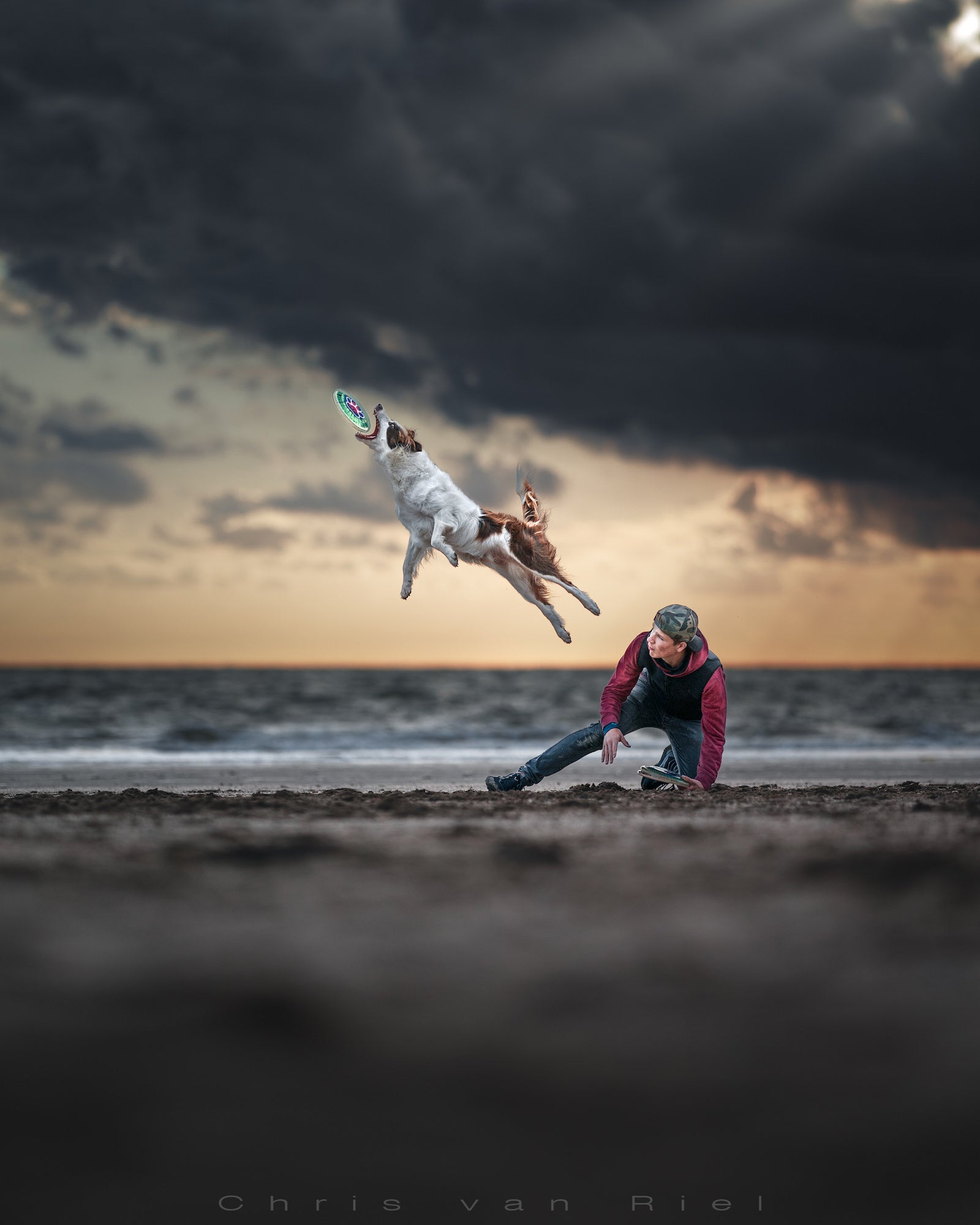In this article we connect with photographer Chris Van Riel (@vanrielchris) to learn more about how he photographs dogs soaring through the air like superheroes.
Dutch photographer Chris Van Riel (@vanrielchris) started a series photographing the dog-disc sport, and we can’t get enough of the resulting action-packed images. We connected with Van Riel to learn more about his process for photographing these canines in action. Keep reading for his step-by-step guide to getting crisp and professional action shots of our four-legged friends fetching flying discs.
Who doesn’t love photos of dogs soaring through the air like superheroes? Chris Van Riel explains his step-by-step process for photographing these canines in action.

Photo by Chris Van Riel. Sony Alpha 9. Sony 135mm f/1.8 G Master. 1/8000-sec., f/1.8, ISO 100
Step 1: Know What You Need To Make A Good Image
Before getting into the process, Van Riel says it all starts with the understanding of what a good image needs to have. “If you see my images, I always have a depth of field. That's really important to make it look good. It needs to be really sharp, so you need a fast shutter speed and you need a long focal lens. You want these because if the background is far away, you'll have lots of treetops and stuff going on, and it's really hard to track action when you don't have enough distance. So those are three things that you need.” Van Riel uses the Sony Alpha 9 and Sony 135mm f/1.8 G Master combination to capture his dog-disc sport images. (Editor’s note: Learn more about why he chooses them in his Alpha Universe Profile Spotlight.)
“What I really like seeing in a dog-disc sport photo is all four of the paws, the eyes and a smooth background with no treetops. I also really like seeing when the disc is right in front of the dog's mouth and then when the tail is in the picture. When the disc is separated from the dog's teeth and he's just about to grab it, that's the perfect moment. They make a really funny facial expression and it's an incredibly hard moment to capture.”

Photo by Chris Van Riel. Sony Alpha 9. Sony 135mm f/1.8 G Master. 1/2000-sec., f/1.8, ISO 125
Step 2: Set Up At A Low Angle
Van Riel says that when you start photographing a dog, it’s easiest to start from the side and have the dog move past you. “Because when they are coming straight at you,” he explains, “you are going to need very specialized equipment to really make it work. So for the first dog, you are just going to set up at a really low angle. What I do is lay down with my camera until I can look almost underneath the dog. The low perspective next to the floor only takes up a really small portion of the frame. Everything else is the environment, and that's really important to make pictures look good. Because if you're shooting from a high perspective, the floor will also become the background since you're photographing at a downwards angle. That's what you're really trying to prevent here.”
Step 3: Get The Right Distance
Next, he says that you want to make sure you have the right distance from the dog to nail your composition in camera. “What you can see in most of my shots is I don't have any treetops in them,” Van Riel explains. “You want to focus on your background first, so you're going to look through your camera and walk backwards until treetops start coming into your frame. Then you take a few steps back to where you came from. That's where you want to be. That's where you have the most amount of distance between your background and your dog. Because the dog is going to be somewhere in between it and you want as much distance as possible to make the dog really stand out. The depth of field is not enhanced, it's just the way it is straight out of the camera.”

Photo by Chris Van Riel. Sony Alpha 9. Sony 135mm f/1.8 G Master. 1/10000-sec., f/1.8, ISO 100
Step 4: Expose For The Highlights
As Van Riel has his distance set, he wants to make sure he’s exposing for the highlights in order to keep as much detail as he can. “I always make sure I expose for highlights, because it’s important to help make the image have that cool look,” he says. “It's just important to keep all of the detail you can. So you're going to expose for the highlights, and as a result of that, you are going to have an ISO value of something with your aperture wide open – it's aperture always wide open.”
“You want your shutter speed to be at least 1/1250-sec. For higher megapixel cameras, I would recommend going to at least 1/2000-sec. for your shutter speed. You need a little bit more speed when working with high megapixel equipment because when you zoom in you’re going to see noise from motion if you don’t go fast enough. For your ISO, maybe it’s low at 100 if you have enough sun or maybe you’re going to have to raise it depending on the conditions.”
Step 5: Set A Large Focus Area
Since he has an idea, but isn’t completely sure where the dog will end up in the air, Van Riel likes to set a large focus area. “You can see how hard it is to track the dog midair, especially with a really small dog,” Van Riel says. “It's incredibly difficult. So I really like to use a big zone where the dog has to stay within it. As soon as I pre-focus, the camera really does a good job of just keeping everything in focus. When I come from a shoot, I usually have 4500 images, and I think the amount of shots I miss are no more than 20. With a fast lens, it’s just mind-blowing.”
Step 6: Work With The Handlers On Timing
When photographing the dog-disc sport, Van Riel aims to have experienced dogs and handlers so the dogs have a healthy and happy time. He works with the handlers on when to throw the disc and let the dog run so he can capture the images at just the right time. “Here in The Netherlands, dog sports are really popular. This dog and the trainer are a team. They train together on a weekly basis, and it's all very high skill. The training and the skill of the dog and the handler are very important for the quality of the shots and also for safety. If you're going to do this with people who are new to the sport or just not experienced enough or the dogs are old or just have medical issues, it's really easy for animals to get irritated. You don't want that. You want to work with dogs who are well trained.”
Photo by Chris Van Riel. Sony Alpha 9. Sony 135mm f/1.8 G Master. 1/4000-sec., f/1.8, ISO 100
“You’ll need to repeat this a lot of times, because not every jump makes for a good photo. Sometimes they turn their head away from you and you can’t see the eyes or the teeth of the dog, or sometimes the timing is just slightly off and the disc is already between the teeth. There's so much that can go wrong every jump. So you need to make sure that you eliminate every inconsistency that you can.”
See more of Chris Van Riel’s work on his Alpha Universe Profile and on Instagram @vanrielchris.




